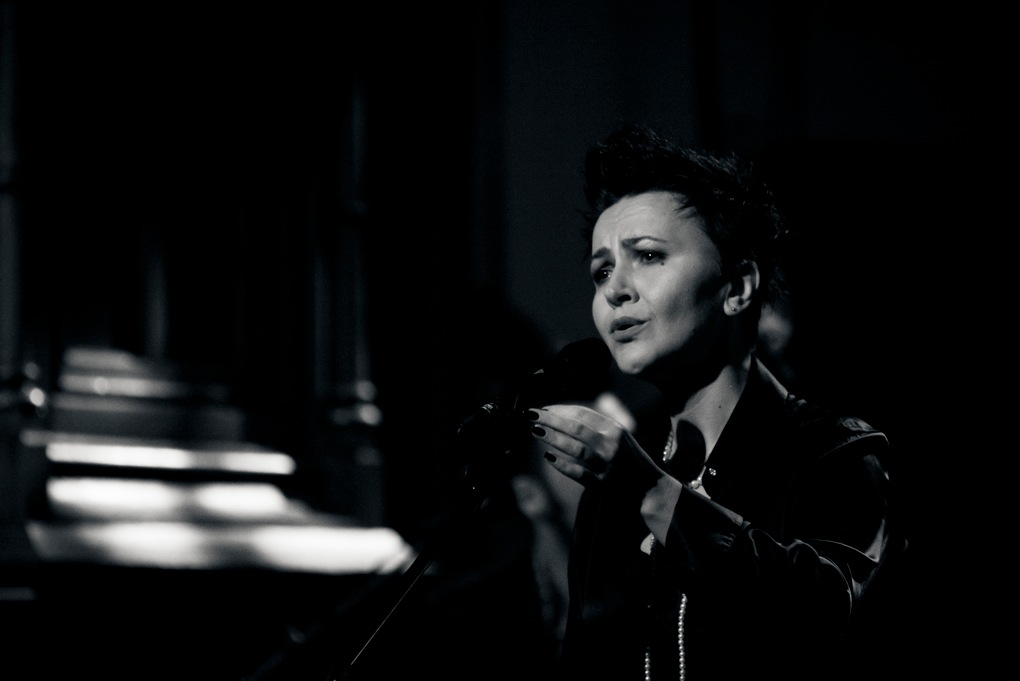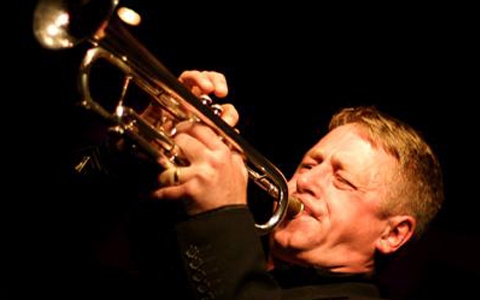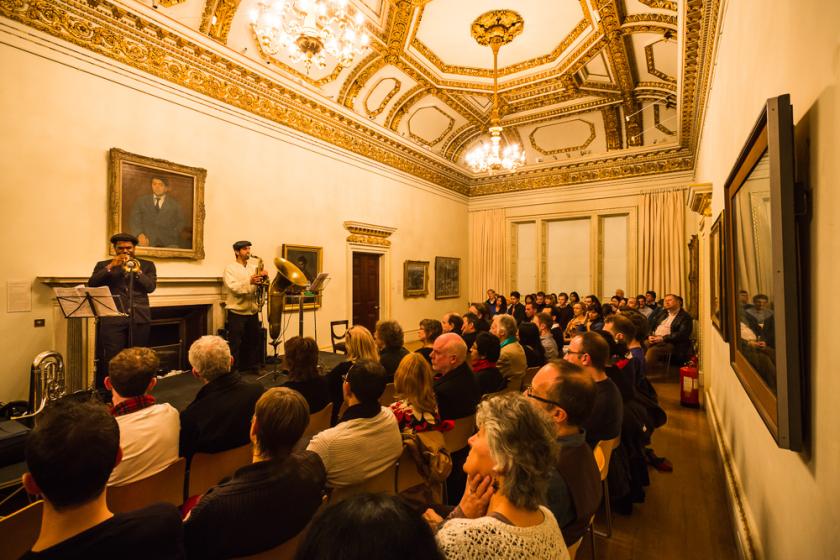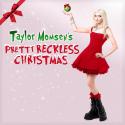Squeezing nearly 300 events into the 10-day dash that is the London Jazz Festival, which has just ended required dozens of venues – many not regular presenters of jazz – to open their doors. From the 606 Club in the west to Oliver’s Bar in Greenwich in the east, the Finchley Arts Depot in the north to the Hideaway down south in Streatham, it is in the pubs, clubs and community venues of London that the jazz festival’s heart beats.
The fringe also better reflects the continuing internationalisation of the London Jazz Festival. Where the Southbank and Barbican tend to present the American and British jazz greats of past and present (this year Herbie Hancock, Brad Mehldau, Jack DeJohnette, Esperanza Spalding), the billing elsewhere was stronger on artists from across Europe, Africa and beyond who owe as much to their own roots music as to the label jazz.
A wild variety of sounds and textures piled on top of each other
A truly international festival needs a global audience and London certainly has that to offer. Two artists from opposite ends of Europe proved as much in gigs which both sometimes resembled expat reunions. The young fado singer Carminho received more than just a mumble of assent when she asked whether any of the Purcell Room audience were Portuguese. At 28 and with just two albums under her belt, she could have been forgiven for easing herself in slowly but she committed from the off with a highly wrought song of searing intensity. Immaculately accompanied by a guitar trio led by the smooth Portuguese-guitar virtuoso Luis Guerreiro, Carminho kept up a similar level of drama over two sets. Whether singing sotto voce or at volume, her mouth and face contorted to achieve the inflections of songs of love and loss from her homeland, she was always in control of the remarkable, full-toned voice she inherited from her fadista mother.
 One of Carminho’s encores, a festival song from Lisbon, was politely picked up by her watching compatriots. The singing that accompanied the closing numbers at the Finchley Arts Depot a few nights earlier was more raucous, reflecting the informal spirit of the Balkans. The diva this time was Amira (pictured right), the leading singer of sevdah – the melancholic, soulful songs of Bosnia – of her generation. Amira’s appearance had more definite links to jazz. On her 2011 album Amulette, she combined the ornamented melodies of sevdah with a trio led by Serbian jazz pianist Bojan Z. The two styles make a better fit live than on record. The rhythmic freedom of Amira’s vocal lines was accentuated by Bojan and bassist Nenad Vasilic in tunes from Bosnia, Serbia, Macedonia and Kosovo. Bojan’s playing ranged from melodic to angular, the latter approach producing a satisfying contrast to Amira’s rich, velvety voice in the most mournful, atmospheric songs.
One of Carminho’s encores, a festival song from Lisbon, was politely picked up by her watching compatriots. The singing that accompanied the closing numbers at the Finchley Arts Depot a few nights earlier was more raucous, reflecting the informal spirit of the Balkans. The diva this time was Amira (pictured right), the leading singer of sevdah – the melancholic, soulful songs of Bosnia – of her generation. Amira’s appearance had more definite links to jazz. On her 2011 album Amulette, she combined the ornamented melodies of sevdah with a trio led by Serbian jazz pianist Bojan Z. The two styles make a better fit live than on record. The rhythmic freedom of Amira’s vocal lines was accentuated by Bojan and bassist Nenad Vasilic in tunes from Bosnia, Serbia, Macedonia and Kosovo. Bojan’s playing ranged from melodic to angular, the latter approach producing a satisfying contrast to Amira’s rich, velvety voice in the most mournful, atmospheric songs.
Staying in the East, two very different Balkan-inspired bands played East London venues. At Richmix in Shoreditch, a double bill featured the Nicolas Simion Group after a probing but rather dry set by British multi-instrumental duo Ivo Neame and Jim Hart. Veteran reeds-man Simion is from Romania and Transylvanian music informs his jazz, yet the influence didn’t always come across with this quartet of reeds, accordion, electric bass and drums. Martin Lubenov’s accordion tended to get lost next to Simion’s powerful and lyrical soprano and tenor sax playing, while his solos were technically impressive but two-dimensional. Except for the final couple of numbers, Simion’s tunes seemed to draw more from hard bop and funk rather than any overt Romanian references. While the ensemble playing was impressive, the set never really took off.
There was nothing to baffle the previous night at the ever-excellent Vortex jazz club in Dalston, regulars Dunajska Kapelye (the Danube Band, in translation) treated a full house to some uncomplicated gypsy vigour. Polish violinist and gypsy music nut Piotr Jordan fronts the froup and while his eccentric stage banter may mark him out as an unlikely bandleader, he is the driving force behind the band’s prowess with their adopted music. His idiosyncratic playing and habit of intermingling – and even blending – wild Balkan tunes with the jazz manouche of Django Reinhardt is the key to the band’s charm. While their performance was sometimes so raw as to appear unprepared, Jordan seemed to revel in the chaos, leading manic dances from all over Eastern Europe.
 British jazz, both traditional and experimental, was also strongly represented right across the festival, with opportunities to see leading artists of all stripes at interesting venues. On the first anniversary of the passing of a very English figure in British jazz, trumpeter Gabriel Garrick (pictured) led a big band tribute to his dad Michael at the Spice of Life. His 16-piece orchestra took up a lot of space in the confines of the underground Soho bar. The intimacy made for an intense portrait of Garrick senior’s clever big band writing, which eschews bombastic tunes and hard swing for complex, whimsical and sometimes oblique compositions that display a brilliant, orchestral use of texture. This lunchtime gig also fell on Remembrance Sunday, and the theme of loss and remembering was accentuated by a poem by Garrick senior (well known for fusing poetry and jazz), read by Gabriel, entitled "Cadet’s Corpse".
British jazz, both traditional and experimental, was also strongly represented right across the festival, with opportunities to see leading artists of all stripes at interesting venues. On the first anniversary of the passing of a very English figure in British jazz, trumpeter Gabriel Garrick (pictured) led a big band tribute to his dad Michael at the Spice of Life. His 16-piece orchestra took up a lot of space in the confines of the underground Soho bar. The intimacy made for an intense portrait of Garrick senior’s clever big band writing, which eschews bombastic tunes and hard swing for complex, whimsical and sometimes oblique compositions that display a brilliant, orchestral use of texture. This lunchtime gig also fell on Remembrance Sunday, and the theme of loss and remembering was accentuated by a poem by Garrick senior (well known for fusing poetry and jazz), read by Gabriel, entitled "Cadet’s Corpse".
The following lunchtime and St James’s Church in Piccadilly was full to bursting for a trio gig led by one of the UK’s most treasured jazz pianists, Nikki Iles. With bassist Mick Hutton and drummer Jeff Williams, Iles presented pieces from her recent and much acclaimed album Hush. It’s not difficult to understand why it is a popular record. Iles presides over a classic jazz trio sound, melodic and swinging, and the playing of these experienced musicians was smart and spry. Iles moved between mid-range chord-work and high, silky runs, always in sync with Williams’ shimmering, unobtrusive drumming and Hutton’s crisp, articulate bass.
A few doors down from St James’s, the Royal Academy invited the jazz festival into the long, painting-lined Reynolds Room on the first floor. Happily, the civilised surroundings didn’t rub off on Byron Wallen (trumpet) and Oren Marshall (tuba), who provided brassy pyrotechnics over two endlessly creative sets. Aside from a few straight-forwardly tuneful moments, a soulful version of "I Wish I Knew How it Would Feel to be Free" and a glorious New Orleans-style march, their show was about pushing themselves and their instruments to the limit. Wallen and Marshall took it in turns to lead long, sprawling pieces of hard-blowing, effects-laden playing, often building a layer of loops and then taking turns to improvise at full-tilt on top. A wild variety of sounds and textures piled on top of each other, from didgeridoo effects on the tuba to Wallen blowing into seashells of different sizes, playing them like they were any other horn. This was chalk to Nikki Iles’s cheese but that’s the beauty of the festival: all jazz was here.















Add comment